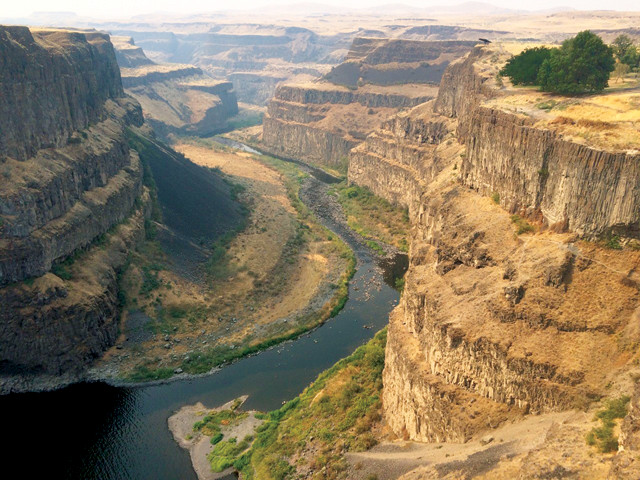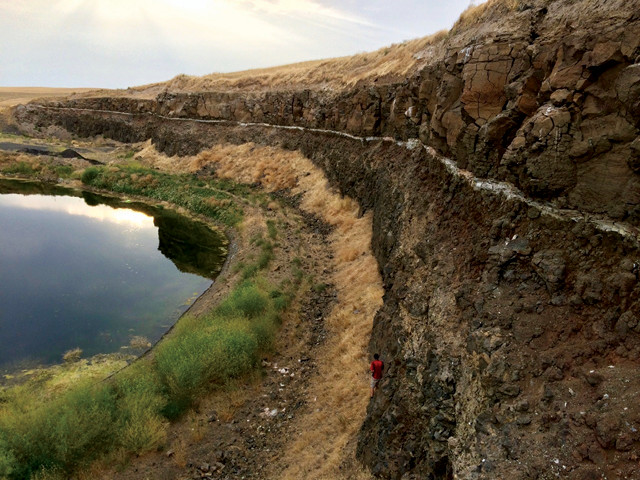
by Sarah Derouin Friday, December 21, 2018

Lava flows of the Wanapum Basalt, the second-youngest formation of the Columbia River Basalt Group (CRBG), are exposed in Palouse Falls State Park along the Palouse River in eastern Washington. Researchers recently found that most of the CRBG lava erupted over a period of about 758,000 years, faster than previously thought. Credit: Jennifer Kasbohm, Princeton University.
Editor’s note: This story appeared in print in the January issue of the magazine. The version below has been updated to note that the areal extent of the Columbia River Basalt Group (CRBG) exceeds 200,000 square kilometers. This value was previously given as 163,700 square kilometers. Additionally, the story has been amended to acknowledge prior research that suggested that more than 90 percent of the CRBG volume erupted over a roughly 1.1-million-year period.
Update (1/16/19, 4:00 p.m. ET): The description of paleosols as “sediment layers” has been changed to " ancient soil layers" to more accurately reflect that paleosols are preserved soils — not simply preserved sediments — in the stratigraphic record.
In the Pacific Northwest, oozing volcanic basalts erupted over the landscape during the middle Miocene, layering a sequence of 43 distinct strata, comprising roughly 350 individual flows, up to 2 kilometers thick over roughly 210,000 square kilometers. The timeline over which all that rock, known as the Columbia River Basalt Group (CRBG), piled up — and the pace at which it did so — hasn’t been as clear as scientists would like, in part because prior dates for the lava flows have come with large uncertainties. But in a new study in Science Advances, researchers have reduced those uncertainties and shown that the vast majority of the massive CRBG was deposited in less than a million years, faster than was previously thought.
Similar — albeit somewhat larger — flood basalts have been linked to mass extinction events, such as the Deccan Traps, which have been implicated in the end-Cretaceous extinction 66 million years ago. There’s no mass extinction associated with the CRBG, but it’s thought that the CRBG eruptions could have overlapped in time with, and thus played a role in causing, the mid-Miocene Climate Optimum (MMCO), a period of elevated sea-surface temperatures, large-scale vertebrate migrations and the emergence of new species between about 17 million and 15 million years ago.

A thin, light-colored ash layer lies between flows of the Wanapum Basalt. Zircons found in such layers were used to constrain the timing of the CRBG eruptions. Credit: Jennifer Kasbohm, Princeton University.
To examine how well the CRBG eruptions and the MMCO overlapped, Princeton University geochemists Jennifer Kasbohm and Blair Schoene set out to determine more precisely when — and how fast — the CRBG lavas were deposited. They concentrated not on the basalts themselves, but on ancient soil layers, called paleosols, preserved between different lava flows. “We started collecting massive amounts of these paleosols,” which tend to be rich in ash and zircons erupted from nearby Cascade volcanoes, Schoene says.
The zircons, ranging from 50 to 200 microns across, crystalized in magma shortly before it erupted and then rained down as ash over the CRBG flows. As the zircons contain radioactive uranium that decays at a known rate, they act as geological clocks, indicating when they erupted as well as the age of the paleosols between adjacent basalt flows. By dating the youngest zircons in eight different paleosol layers, Kasbohm and Schoene better bracketed the timing and duration of the CRBG flows.
Prior research suggested that about 93 percent of the CRBG’s volume erupted within a roughly 1.1-million-year-period between 16.7 and 15.6 million years ago, but dates in that work — obtained using argon dating methods — came with error estimates of hundreds of thousands to more than a million years. In the new study, Kasbohm and Schoene found that 95 percent of the CRBG lavas erupted within about 758,000 years between 16.7 million and 15.9 million years ago, achieving uncertainties of just tens of thousands of years with their uranium dating technique. Understanding the rate of the eruptions is crucial in determining how much and how quickly carbon dioxide is released, and how that gas might affect the climate, Schoene says. “If [the basalts] all erupt in one day, then you get all the carbon dioxide at once,” he says. Alternatively, if it took 2 million or 3 million years, the carbon dioxide would be emitted more slowly and would “likely be sequestered in the oceans and not build up in the atmosphere.”
“There is a lot of debate about the extent to which volcanic eruptions in general — and in particular these very large sequences of volcanic eruptions that produce flood basalt provinces — could have influenced climate,” says Kari Cooper, a geochemist at the University of California, Davis, who was not involved with the study. She notes that understanding how long these eruptions last is the first step in looking at climate causality. Although the rate of eruption and gas release isn’t “always a one-to-one correlation” she says, understanding the timing is important “because the rate at which you’re pumping volcanic gases into the atmosphere can have a really big effect on climate.”
Kasbohm and Schoene looked at how their amended eruption timing for the CRBG may have related to the MMCO, but “it ended up being a lot harder than we had hoped,” Schoene says. Miocene climate is primarily recorded in sedimentary carbonates from the oceans, he says, many of which don’t contain any material that can be dated directly. Instead, their timing is determined by using paleomagnetic records of reversals in Earth’s magnetic field in the rocks and by correlating the carbonate stratigraphy with other rock packages that have been dated elsewhere. Moving forward, Schoene says, refinement of the carbonate ages around these magnetic reversals will improve the correlation between rock units and constrain the timing of change in the Miocene climate — a project on which Kasbohm is currently working.
For now, Cooper says, the researchers did a really nice job of looking in detail at a sequence that was previously dated. She adds that this work shows the value in re-examining geologic sequences and questioning assumptions, especially as new dating techniques are developed. Cooper says the team’s approach of re-dating the well-studied CRBG helps refine the Miocene chronology and “interpret how this fits into the global climate.
© 2008-2021. All rights reserved. Any copying, redistribution or retransmission of any of the contents of this service without the expressed written permission of the American Geosciences Institute is expressly prohibited. Click here for all copyright requests.